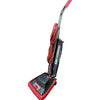
Bagged vs. Bagless Vacuum Cleaners
Bagged or Bagless? The Basics.
All vacuum cleaners essentially have the same function – they intake air, dirt, and debris and have to expel the excess air to ensure that the machine does not explode or malfunction. The goal, of course, is to release the extra air without expelling any dirt or debris. This is where the difference occurs because there are two methods to trapping the dirt, bag and bagless.
This May Surprise You…
While bagless vacuums are typically regarded as the improved form of vacuuming, bagless vacuums are actually the original concept. Most of us think of the vacuums our parents used when we were kids. You know, the red Hoover with the bag that would fill up, and Mom or Dad would toss it when they were finished. However, those vacuums of the 80s and 90s were actually the improved model.
The original vacuums that were marketed and sold long before the bagged versions did not have any disposable bags. Instead, as the chamber or cloth bag filled with dirt, you would have to empty and clean the collective component by hand. This, of course, involved getting your hands and likely your space dirty.
As disposable, paper vacuum bags were introduced, it made the process cleaner and more streamlined. The disposable paper bag was viewed as a much-needed improvement to both the industry and the consumer. The bagged system made the process cleaner, more effective, and was a much more successful filtration method.
Don’t Call it a Comeback
Though bagged vacuums were an improvement and a success among customers, their reign supreme did not last long. The bagless, or dirt cup, vacuums made a “comeback” in the 90s. Rather than disclosing their past, vacuum manufacturers instead touted the bagless models as something that was new and innovative – something that was going to evolve vacuums. This is particularly humorous as the bagged models were an evolution of the bagless vacuums.
Consumers soon bought into the idea that bagless vacuums were the new and superior product. However, they rarely considered the impact of a bagless vacuum, including the cost of filters, filtration issues, poor indoor air quality, maintenance, and of course, the mess involved with emptying the cup. Vacuum quality and repairability still remain to be a problem.
Here are the Hard Facts
There are a few different claims that are somewhat misguided when it comes to bagless versus bagged vacuums. The first is that you need to change the bag of a bagged vacuum more often than you have to clean the chamber and filters of a bagless. The truth is that most vacuum bags hold up to 10-15 times more dirt and debris than a dirt cup or chamber model. While most using bagless vacuums have to clean out the cup with each use, those using the bagless vacuums will typically remove the bag once every other month.
Even experts agree that bagged vacuums are likely the better option as it applies to purchasing a new vacuum. Bagged vacuums with proper working filters emit little to no particles back into the air through the exhaust. This means that you won’t create a mess behind the one you just cleaned, as bagless vacuums usually allow more dirt, dust, and debris to escape the chamber and reenter your space.
The bags within bagged vacuums have evolved in ways that you would never imagine. These bags continue to operate without any problems. Today’s bags only have to be replaced every 1-3 months, depending on your home’s size and how often you vacuum. Even more convenient, most bagged vacuums have an indicator that lets you know when it is time to change the bag. In contrast, bagless or dirt cup vacuums require that you clean or replace the chamber on a much more regular basis.
These differences may not seem apparent. However, bagged vacuums just retain more airflow. When you replace your bag, your vacuum operates at a peak level and helps you keep your home or business stay clean. Bagless models never reach this level of optimization. Bags tend to be much less expensive for a bagged vacuum model, while the filters for bagless models can become very expensive depending on the brand. Bagless manufacturers recommend replacing filters every 6-12 months.
One of the most prominent arguments for bagless models against bagged vacuums is that bagless vacuums are much more environmentally friendly. The majority of today’s vacuum bags are biodegradable, meaning that they don’t stay in a landfill for eternity and will break down into the soil. However, the filters on bagless models are made of plastic, which is arguably one of the least biodegradable materials on the planet.
The Truth About Bagless Vacuums
Ultimately, bagless vacuums are marketed using slick and gimmicky advertising designed to make you believe that you are buying an evolved and superior product. None of the advertising or focus on these models includes the fact that they are usually more poorly made than bagged models. Those getting ready to or purchasing bagless vacuums often forget to consider how long the machine will last and where it can be serviced.
With industry experts, bagless vacuums are considered to be completely disposable. The reason is that they don’t last long. Sure they are less expensive than bagged models, but how many more bagless vacuums will you buy in your lifetime compared to the bagged type? The bagless vacuum that you eventually end up throwing out will become another fixture on a landfill for years to come. Bagged vacuums, on the other hand, last longer and are easier to rebuild and repair.
703-997-9292
You can visit us at:
11110 Lee Highway, Fairfax, VA 22030 (in Fairfax City, VA) or
- 12 Jan, 2022



































